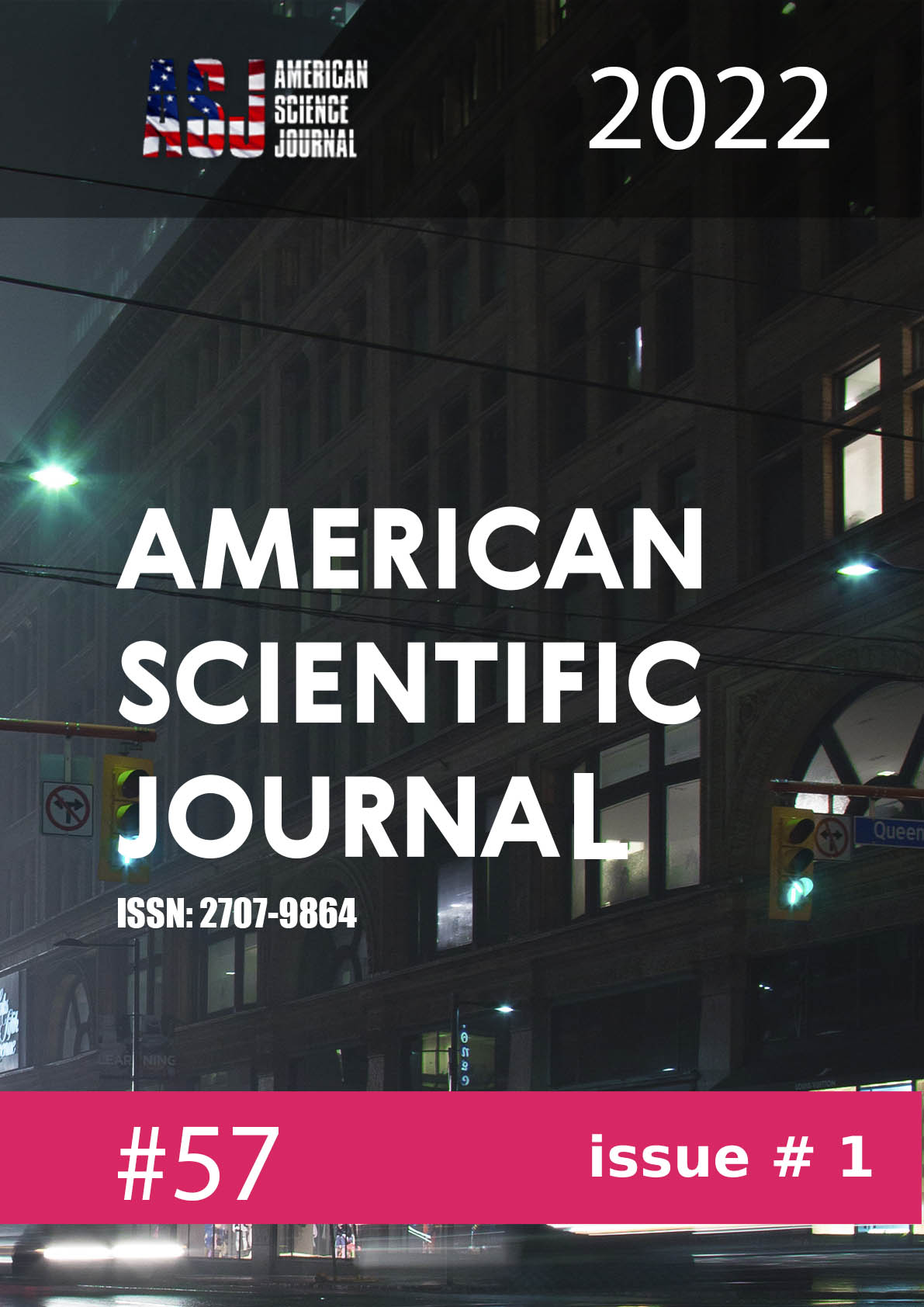OUTCOMES OF SEVERE ASPHYXIA IN NEWBORNS
DOI:
https://doi.org/10.31618/asj.2707-9864.2021.1.57.163Keywords:
newborns, hypoxic-ischemic encephalopathy, therapeutic hypothermiaAbstract
One of the most promising methods to reduce the adverse effects of hypoxic-ischemic damage to the central nervous system in newborns is therapeutic hypothermia. This article provides a retrospective analysis of 27 medical histories of full-term newborns who had a history of severe asphyxia. The patients were divided into two groups. Group I included children (n=15) who received therapeutic hypothermia in the first 2 hours of life. Group II (n=12) included children who suffered severe asphyxia at birth, but did not receive therapeutic hypothermia for a number of reasons. A comparative assessment of the severity of neurological disorders, the duration of treatment in a specialized medical institution and the health status of children at the time of discharge from the hospital was carried out in groups of newborns.
References
Neonatology. Training manuals in 2 volumes. / N.P. Shabalov. - Vol. I - II-M.: "GEOTAR - Media". - 2020 - V. I. - pp. 341-369, 526-584.
Degtyareva M. G. Therapeutic hypothermia in the care of full-term children born in severe asphyxia. Status Presens. Pediatrics and neonatology. 2018. N 1[46]. pp. 71-79.
McGuire W. Perinatal asphyxia // Clin. Evid. – 2006. – V.15. – P. 1–2.
Hayakawa M., ItoY., SaitoS., Mitsuda N., Nosono S., Yoda H., Cho K. Incidence and prediction of outcome in hypoxic-ischemic encephalopathy in Japan. Pediatr. Int. 2014. Vol. 56, N 2. P. 215-221. DOI: 10.1111-12233.
Kurinczuk J.J., White-Koning M., Badawi N. Epidemiology of neonatal encephalopathy and hypoxic-ischemic encephalopathy. Early Hum. Dev. 2010. Vol. 86, N 6. P. 329-338. DOI: 10.1016. 2010.05.010.
Volodin N. N., Degtyarev D. N., Kryuchko D. S. Clinical recommendations. Neonatology. Moscow: GEOTAR - Media, 2019. 320 p. ISBN 978-5-97044946-2.
Degtyarev D. N., Ionov O.V., Kirbataya A.R. Amplitude-integrated electroencephalography and selective hypothermia in neonatology practice. Moscow: Locus-Standi, 2013. - 60 p.
Use and abuse of the APGAR score. Committee on Fetus and Newborn, American Academy of Pediatrics and Gynecologiss. Pediatrics. 1996. Vol. 98, N 1. P. 141-142.
Zadvornov A.A., Golomidov A.V., Grigoriev E. V. Neonatal therapeutic hypothermia: how does it work? Neonatology: news, opinions, training. 2016. N 1. pp. 49-54.
Burov A. A., Gorev V. V., Gorelik K. D., etc. Therapeutic hypothermia in newborn children. Clinical recommendations. - M.: 2019. - 24 p.
Johnston M. V., Hoon A. Possible mechanisms for selective basal ganglia damage in infants from asphyxia, kernicterus, or mitochondrial encephalopathy. J. Child Neurol. 2000. Vol.15. P.588591. DOI: 10.1177/088307380001500904.
Jonston M.V., Trescher W.H., Ishida A., Nakagima W. Neurobiology of hypoxic-ischemic injury in the developing brain. Pediatr. Res. 2001. Vol. 49. N 6. P. 735-741. DOI: 10.1203/00006450200106000-00003.
Barkovich A.J., Westmark K., Partridge C. Perinatal asphyxia: MR findings in thefirst 10 days. AJNR Am. J. Neuroradiol. 1995. Vol. 16. P. 427-438.
VolpeJ.J. Neurology of the newborn. W.B. Saunders Company. 5 ed. Philadelphia. 2008. P. 1120. ISBN: 9781437720792.
Laptook A.R., Corbett R.J., Sterett R., Garcia D., Tollefsbol G. Quantitative relationship between brain temperature and energy utilization rate measured in vivo using 31 P and 1H magnetic resonance spectroscopy. Pediatr. Res. 1995. Vol. 38, N 6. P. 919925. DOI:10.1203/00006450-199512000-00015.
Williams G.D., Dardzinski B.J., Buckalew A.R. Modest hypothermia preserves cerebral energy metabolism during hypoxia-ischemia and correlates with brain damage: a 31 P nuclear magnetic resonance study in unanesthetized neonatal rats. Pediatr. Res.
Vol. 42, N 5. P. 700-708. DOI: 10.1203/00006450-199711000-00024.
Thoresen M., SimmondM., Satas S., Tooley J., Silver I.A. Effective selective head cooling during posthypoxic hypothermia in newborn piglets. Pediatr. Res. 2001. Vol.49. P. 594-599. DOI: 10.1203/00006450-200104000-00024.
BrunoV.M., Goldberg M.P., Dugan L.L., Giffand R.G., Choi D.W. Neuroprotective effect of hypothermia in cortical cultures exposed to oxygenglucose deprivation or excitatory amino acid. J. Neurochem. 1994. Vol. 63, N 4. P. 1398-1406. DOI: 10.1046/j.1471-4159.1994.63041398.x.
Kil H.Y., Zhang J., Piantadosi C.A. Brain temperature alters hydroxyl radical production during cerebral ischemia/reperfusion in rats. J. Cereb. Blood Flow Metab. 1996. Vol. 16, N 1. P. 100-106. DOI: 10.1097/00004647-199601000-00012.
Goss J.R., Styren S.D., Miller P.D., Kochanek P.M., Palmer A.M., Marion D.W., Dekosky S.T. Hypothermia attenuates the normal increase in interleukin 1 beta RNA and nerve growth factor following traumatic brain injury in the rat. J. Neurotrauma. 1995. Vol. 12, N 2. P. 159-167. DOI: 10.1089/neu.1995.12.159.
Fukuda H., Tomimatsu T., Watanabe N., Mu J.W., Kohzuki M., Endo M., Fuil E., Kanzaki T., Murata Y. Post-ischemic hypothermia blocks caspase3 activation in the newborn rat brain after hypoxiaischemia. Brain Res. 2001. Vol. 910, N 1-2. P. 187-191. DOI: 10.1016/s0006-8993(01)02659-2.
Shankaran S., Abbot R., Laptook A.R., Richard A., Ehrenkranz R.A. National Institute of Child Health and Human Development Neonatal Research Network. Whole-body hypothermia for neonates with hypoxic-ischemic encephalopathy. N. Engl. J. Med. 2005. Vol. 353, N 15. P. 1574-1584. DOI: 10.1056/NEjMcps050929.
Downloads
Published
Issue
Section
License

This work is licensed under a Creative Commons Attribution-NoDerivatives 4.0 International License.
CC BY-ND
A work licensed in this way allows the following:
1. The freedom to use and perform the work: The licensee must be allowed to make any use, private or public, of the work.
2. The freedom to study the work and apply the information: The licensee must be allowed to examine the work and to use the knowledge gained from the work in any way. The license may not, for example, restrict "reverse engineering."
2. The freedom to redistribute copies: Copies may be sold, swapped or given away for free, in the same form as the original.
 информационное письмо
информационное письмо


